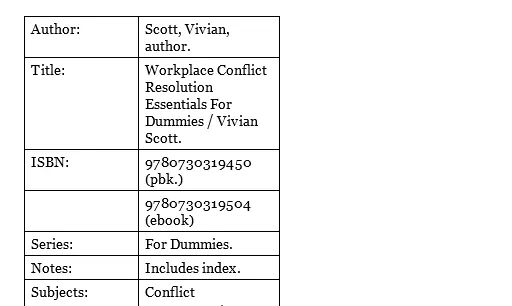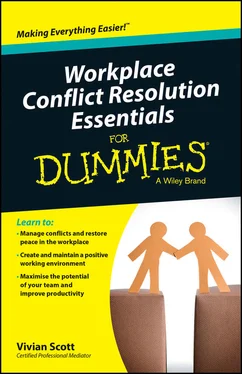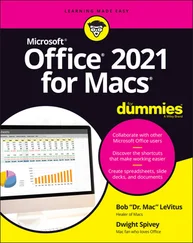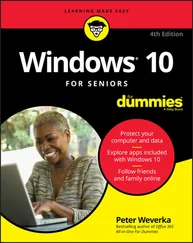Vivian Scott
Workplace Conflict Resolution Essentials For Dummies
Workplace Conflict Resolution Essentials For Dummies ®
Published by
Wiley Publishing Australia Pty Ltd
42 McDougall Street
Milton, Qld 4064
www.dummies.com
Copyright © 2015 Wiley Publishing Australia Pty Ltd
Authorised adaptation of Conflict Resolution at Work For Dummies © 2010 John Wiley & Sons, Ltd. (9780470536438).
The moral rights of the author have been asserted.
National Library of Australia
Cataloguing-in-Publication data:

All rights reserved. No part of this book, including interior design, cover design and icons, may be reproduced or transmitted in any form, by any means (electronic, photocopying, recording or otherwise) without the prior written permission of the Publisher. Requests to the Publisher for permission should be addressed to the Legal Services section of John Wiley & Sons Australia, Ltd, Level 2, 155 Cremorne Street, Richmond, Vic 3151, or email auspermissions@wiley.com.
Cover image: © iStock.com/timsa
Typeset by diacriTech, Chennai, India
Printed in Singapore by
C.O.S. Printers Pte Ltd
10 9 8 7 6 5 4 3 2 1
Limit of Liability/Disclaimer of Warranty: THE PUBLISHER AND THE AUTHOR MAKE NO REPRESENTATIONS OR WARRANTIES WITH RESPECT TO THE ACCURACY OR COMPLETENESS OF THE CONTENTS OF THIS WORK AND SPECIFICALLY DISCLAIM ALL WARRANTIES, INCLUDING WITHOUT LIMITATION, WARRANTIES OF FITNESS FOR A PARTICULAR PURPOSE. NO WARRANTY MAY BE CREATED OR EXTENDED BY SALES OR PROMOTIONAL MATERIALS. THE ADVICE AND STRATEGIES CONTAINED HEREIN MAY NOT BE SUITABLE FOR EVERY SITUATION. THIS WORK IS SOLD WITH THE UNDERSTANDING THAT THE PUBLISHER IS NOT ENGAGED IN RENDERING LEGAL, ACCOUNTING, OR OTHER PROFESSIONAL SERVICES. IF PROFESSIONAL ASSISTANCE IS REQUIRED, THE SERVICES OF A COMPETENT PROFESSIONAL PERSON SHOULD BE SOUGHT. NEITHER THE PUBLISHER NOR THE AUTHOR SHALL BE LIABLE FOR DAMAGES ARISING HEREFROM. THE FACT THAT AN ORGANISATION OR WEBSITE IS REFERRED TO IN THIS WORK AS A CITATION AND/OR A POTENTIAL SOURCE OF FURTHER INFORMATION DOES NOT MEAN THAT THE AUTHOR OR THE PUBLISHER ENDORSES THE INFORMATION THE ORGANISATION OR WEBSITE MAY PROVIDE OR RECOMMENDATIONS IT MAY MAKE. FURTHER, READERS SHOULD BE AWARE THAT INTERNET WEBSITES LISTED IN THIS WORK MAY HAVE CHANGED OR DISAPPEARED BETWEEN WHEN THIS WORK WAS WRITTEN AND WHEN IT IS READ.
Trademarks: Wiley, the Wiley logo, For Dummies, the Dummies Man logo, A Reference for the Rest of Us!, The Dummies Way, Making Everything Easier, dummies.com and related trade dress are trademarks or registered trademarks of John Wiley & Sons, Inc. and/or its affiliates in the United States and other countries, and may not be used without written permission. All other trademarks are the property of their respective owners. Wiley Publishing Australia Pty Ltd is not associated with any product or vendor mentioned in this book.
E very day in offices, retail stores, factories and any number of other workplaces, people are having conflicts with co-workers. It’s normal, natural and nothing to fear. When handled properly, conflict can actually create positive changes and new opportunities in your organisation. Successfully making the shift in your perspective from seeing only the negative in disagreements to seeing the prospect for positive change is the first step to resolving difficulties.
To find positive outcomes in what on the surface looks like a negative situation, you have to become skilled at calming the infernos by helping employees through discussions that prove to them that they can solve their own issues. Become a coach for your team and colleagues – someone they can trust to bring the real and right issues to the table for effective problem solving.
If you can broaden your perspective to include the other person’s point of view, you’re sure to come out of the dispute with a better working relationship. Being at the centre of controversy is never a good idea for anyone, so decide to use the uneasy situation as an opportunity to improve systems, relationships, and your credibility.
In this book, I tell you what the most common causes of workplace conflict are and how to address them by using a proven mediation method and philosophy. And remember: Every story always has more than one side.
About This Book
This book is a tool intended to help managers (or anyone who has a job) work through conflict with peers, subordinates and even bosses. It’s primarily aimed at those employees in organisations who find themselves negotiating difficulties without the benefit of having professional conflict resolution or mediation experience.
Although my focus is on how to facilitate conflict resolution, if you’re the person experiencing conflict, this book outlines the kinds of structures that may be in place to support you, and what will be expected of you during each step of the process. Throughout the book, I also highlight the kinds of attitudes (such as good communication, getting to the underlying issues of the conflict and taking personal responsibility in finding a solution) that can help everyone avoid workplace conflict, no matter what level.
The chapters are chock-full of facilitation techniques and tools that come from successful conflict resolution experts, delivered in a way that’s easy to understand and ready for you to apply right away.
To help make this book easier to navigate, I include the following conventions:
 I introduce new terms in italics and then define them.
I introduce new terms in italics and then define them.
 I use bold text to highlight key words in bulleted lists.
I use bold text to highlight key words in bulleted lists.
Foolish Assumptions
I’m assuming you have a job, paid or volunteer, and that you interact with people. I’m also assuming you have some sort of responsibility – be it keeping the line moving at the manufacturing plant or trying to keep your reputation intact as the star manager in the strongest department of an international corporation. And I’m thinking you’re currently experiencing some trouble. You may be sick and tired of a conflict between two of your employees, you may be bickering with a colleague, or perhaps you’re at a loss as to what to do about the problems between you and your boss. My final assumption? I’m guessing you want to do something about it.
Icons Used in This Book
Throughout the book you’ll notice icons in the page margins to signal something I want you to pay particular attention to. Here are the icons I’ve used and what each represents.
 If I know an easier way to do something or have an idea for creating a better working environment now and in the future, this icon tells you that.
If I know an easier way to do something or have an idea for creating a better working environment now and in the future, this icon tells you that.
 I use this icon to flag some important information that you don’t want to forget.
I use this icon to flag some important information that you don’t want to forget.
 This icon alerts you to common blunders that you want to avoid.
This icon alerts you to common blunders that you want to avoid.
Читать дальше


 I introduce new terms in italics and then define them.
I introduce new terms in italics and then define them. I use bold text to highlight key words in bulleted lists.
I use bold text to highlight key words in bulleted lists. If I know an easier way to do something or have an idea for creating a better working environment now and in the future, this icon tells you that.
If I know an easier way to do something or have an idea for creating a better working environment now and in the future, this icon tells you that. I use this icon to flag some important information that you don’t want to forget.
I use this icon to flag some important information that you don’t want to forget. This icon alerts you to common blunders that you want to avoid.
This icon alerts you to common blunders that you want to avoid.










